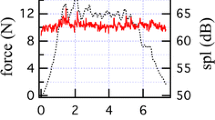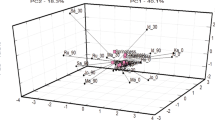Abstract
The objective of this work was to evaluate and correlate rheological properties (small-scale dynamic oscillatory and creep/recovery measurements and large-scale compression force-deformation testing), texture (sensory evaluation by trained panel) and structure (optical and transmission electronic microscopy observations) of apples osmotically dehydrated to water activity (a w) 0.97 with glucose, with or without previous blanching. All apple samples showed a solid behavior (G′ > G″) dominating the viscoelastic response, but both dynamic moduli were reduced due to processing. The instantaneous elastic compliance (J 0) and the retarded compliances (J 1 and J 2) increased for treated tissues and the steady-state viscosity (η N) was approximately 15% to 29% of the value of fresh apple. In general, compression parameters decreased for all treated tissues. Changes in structural features were mainly evidenced in heated samples. Partial least squares regression analysis regression models revealed that texture could be well predicted by rheological properties (compression and creep parameters). Juiciness, crispness and sensory hardness were negatively correlated to J 0, J 1 and J 2, and η N was negatively correlated to sensory fracturability. Some mechanical parameters (fracturability, hardness 2, area 2, modulus of deformability and cohesiveness) were positively related to sensory fracturability, crispness and sensory hardness; and juiciness was negatively correlated to hardness. Compression and creep parameters showed ability to evidence structure differences (rupture of membranes, swelling of cells and degradation of cell walls) and to explain texture of treated apples.









Similar content being viewed by others
References
Alvarez, M. D., & Canet, W. (1998). Rheological characterization of fresh and cooked potato tissues (cv. Monalisa). Zeitschrift für Lebensmittel-Untersuchung und -Forschung, 207, 55–65.
Alzamora, S. M., Cerrutti, P., Guerrero, S., & López-Malo, A. (1995). Minimally processes fruits by combined methods. In G. V. Barbosa-Cánovas & J. Welti-Chanes (Eds.), Food preservation by moisture control: fundamentals and applications (pp. 463–492). Lancaster: Technomics Publishing.
Alzamora, S. M., Gerschenson, L. N., Vidales, S., & Nieto, A. (1997). Structural changes in the minimal processing of fruits: Some effects of blanching and sugar impregnation. In P. Fito, E. Ortega-Rodríguez, & G. V. Barbosa-Cánovas (Eds.), Food engineering 2000 (pp. 117–140). New York: Chapman & Hall.
Alzamora, S. M., Castro, M. A., Nieto, A. B., Vidales, S. L., & Salvatori, D. M. (2000). The rol of tissue microstructure in the textural characteristics of minimally processed fruits. In S. M. Alzamora, M. S. Tapia, & A. López-Malo (Eds.), Minimally processed fruits and vegetables (pp. 153–171). Maryland: Aspen.
Alzamora, S. M., Viollaz, P. E., Martínez, V. Y., Nieto, A. B., & Salvatori, D. M. (2008). Exploring the linear viscoelastic properties structure relationship in processed fruit tissues. In G. E. Gutiérrez-López, G. V. Barbosa-Cánovas, J. Welti-Chanes, & E. Parada-Arias (Eds.), Food Engineering: Integrated Approaches (pp. 133–214). New York: Springer.
Bourne, M. C. (1976). Texture of fruits and vegetables. In J. M. DeMan, P. W. Voisey, V. F. Rasper, & D. W. Stanley (Eds.), Rheology and texture in food quality (pp. 275–307). New York: Van Nostrand Reinhold/AVI.
Bourne, M. C. (1978). Texture Profile Analysis. Food Technology, 32, 62–66.
Bourne, M. C., & Comstock, S. H. (1981). Effect of degree of compression on texture profile parameters. Journal of Texture Studies, 12, 201–216.
Calzada, J. F., & Peleg, M. (1978). Mechanical interpretation of compressive stress–strain relationships of solids foods. Journal of Food Science, 43, 1087–1092.
Castelló, M. L., Igual, M., Fito, J. P., & Chiralt, A. (2009). Influence of osmotic dehydration on texture, respiration and microbial stability of apple slices (Var. Granny Smith). Journal of Food Engineering, 91, 1–9.
Chauvin, M. A., Younce, F., Ross, C., & Swanson, B. (2008). Standard scales for crispness, crackliness and crunchiness in dry and wet foods: relationship with acoustical determinations. Journal of Texture Studies, 39, 345–368.
Chauvin, M. A., Ross, C., Pitts, M., Kupferman, E., & Swanson, B. (2010). Relationship between instrumental and sensory determination of apple and pear texture. Journal of Food Quality, 33, 181–198.
Chiralt, A., & Fito, P. (2003). Transport mechanisms in osmotic dehydration. The role of the structure. Food Science and Technology International, 9, 179–186.
Chiralt, A., Martínez-Navarrete, N., Martínez-Monzó, J., Talens, P., Moraga, G., Ayala, A., et al. (2001). Changes in mechanical properties throughout osmotic processes. Cryoprotectant effect. Journal of Food Engineering, 49, 129–135.
Civille, G. V., & Szczesniak, A. S. (1973). Guidelines to training a texture profile panel. Journal of Texture Studies, 4, 204–223.
D’Ambrogio de Argüeso, A. (1986). Manual de Técnicas en Histología Vegetal. Buenos Aires: Hemisferio Sur S.A.
Dermesonlouoglou, L. K., Pourgouri, S., & Taoukis, P. S. (2008). Kinetic study of the effect of the osmotic dehydration pre-treatment to the shelf life of frozen cucumber. Innovative Food Science and Emerging Technologies, 9, 542–549.
Garcia Loredo A B & Guerrero S N (2011) Correlation between instrumental and sensory ratings by evaluation of some texture reference scales. International Journal of Food Science and Technology, in press, doi:10.1111/j.1365-2621.2011.02709
Giangiacomo, R., Torreggiani, D., Erba, M. L., & Messina, G. (1994). Use of osmodehydrofroozen fruit cubes in yogurt. Italian Journal of Food Science, 6, 345–350.
Harker, F. R., Amos, R. L., Echeverria, G., & Amdgunson, F. A. (2006). Influence of texture on taste: insights gained during studies of hardness, juiciness, and sweetness of apple fruit. Journal of Food Science, 71(2), S77–S82.
Hough, G., Contarini, A., & Muñoz, A. (1994). Training a texture profile panel and constructing standard rating scales in Argentina. Journal of Texture Studies, 25, 45–57.
Ilker, R., & Szczesniak, A. S. (1990). Structural and Chemical bases for texture of plant foodstuffs. Journal of Texture Studies, 21, 1.
Jack, F. R., Paterson, A., & Piggott, J. R. (1995). Perceived texture: direct and indirect methods for use in product development. International Journal of Food Science and Technology, 30, 1–12.
Jackman, R. L., & Stanley, D. W. (1995). Creep behaviour of tomato pericarp tissue as influenced by ambient temperature ripening and chilled storage. Journal of Texture Studies, 26, 537–552.
John, M. A., & Dey, P. M. (1986). Postharvest changes in fruit cell walls. Advances in Food Research, 30, 139–193.
Khin, M. M., Zhou, W., & Yeo, S. Y. (2007). Mass transfer in the osmotic dehydration of coated apple cubes by using maltodextrin as the coating and their textural properties. Journal of Food Engineering, 81, 514–522.
Kunzek, H., Kabbert, R., & Gloyna, D. (1999). Aspects of material science in food processing: changes in plant cell walls of fruits and vegetables. Zeitschrift für Lebensmittel-Untersuchung und -Forschung A, 208, 233–250.
Martens, M., & Martens, H. (1986). Partial least squares regression. In J. R. Piggot (Ed.), Statistical procedures in food research (pp. 293–359). London: Elsevier.
Martínez, V. Y., Nieto, A. B., Viollaz, P. E., & Alzamora, S. M. (2005). Viscoelatic behaviour of melon tissue as influenced by blanching and osmotic dehydration. Journal of Food Science, 70, 12–18.
Martínez, V. Y., Nieto, A. B., Castro, M. A., & Alzamora, S. M. (2007). Viscoelastic characteristics of Granny Smith apple during glucose osmotic dehydration. Journal of Food Engineering, 83, 394–403.
Matuska, M., Lenart, A., & Lazarides, H. N. (2006). On the use of edible coatings to monitor osmotic dehydration kinetics for minimal solids uptake. Journal of Food Engineering, 72, 85–91.
Meilgaard, M., Civille, G. V., & Carrt, B. T. (2006). Sensory Evaluation Techniques (4th ed.). Florida: CRC.
Meullenet, J., Lyon, B. G., Carpenter, J. A., & Lyon, C. E. (1998). Relationship between sensory and instrumental texture profile atributes. Journal of Sensory Studies, 13, 77–93.
Mittal, J. P., & Mohsenin, N. N. (1987). Rheological characterization of apple cortex. Journal of Texture Studies, 18, 65–93.
Nieto, A., Salvatori, D., Castro, M. A., & Alzamora, S. M. (1998). Air drying behaviour of apples as affected by blanching and glucose impregnation. Journal of Food Engineering, 36, 63–79.
Ochoa-Martínez, L. A., García-Quintero, M., Morales-Castro, J., Gallegos-Infante, A., Martínez-Sánchez, C. E., & Herman-Iara, E. (2006). Effect of CaCl2 and convective-osmotic drying on texture and preference of Apple. Journal of Food Quality, 29, 583–595.
Pitt, R. E. (1992). Viscoelastic properties of fruits and vegetables. In M. A. Rao & J. F. Steffe (Eds.), Viscoelastic properties of foods (pp. 49–76). London: Elsevier.
Reynolds, E. S. (1963). The use of lead citrate at high pH as an electron-opaque stain for electron microscopy. The Journal of Cell Biology, 17, 208.
Roa, V., & Tapia de Daza, M. S. (1991). Evaluation of water activity measurements with a dew point electronic humidity meter. Lebensmittel Wissenchaft und Technologie, 24, 208–213.
Salvatori, D. M., & Alzamora, S. M. (2000). Structural changes and mass transfer during glucose infusio´n of apples as affected by blanching and process variables. Drying Technology, 18, 21–48.
Sherman, P. (1970). Industrial rheology. New York: Academic.
Szczesniak, A. S., & Ilker, R. (1988). The meaning of texture characteristics—juiciness in plant foodstuffs. Journal of Texture Studies, 19, 66–78.
Thybo, A. K., & Martens, M. (1998). Development of a sensory texture profile of cooked potatoes by multivariate data analysis. Journal of Texture Studies, 29, 453–468.
Wu, J., & Guo, K. G. (2010). Dynamic viscoelastic behavior and microstructural changes of Korla pear (Pyrus bretschneideri rehd) under varying turgor levels. Biosystem Engineering, 106(4), 485–492.
Acknowledgments
The authors acknowledge the financial support from the University of Buenos Aires, CONICET, Agencia Nacional de Promoción Científica y Tecnológica of Argentina and BID.
Author information
Authors and Affiliations
Corresponding author
Rights and permissions
About this article
Cite this article
Garcia Loredo, A.B., Guerrero, S.N., Gomez, P.L. et al. Relationships between rheological properties, texture and structure of apple (Granny Smith var.) affected by blanching and/or osmotic dehydration. Food Bioprocess Technol 6, 475–488 (2013). https://doi.org/10.1007/s11947-011-0701-9
Received:
Accepted:
Published:
Issue Date:
DOI: https://doi.org/10.1007/s11947-011-0701-9




